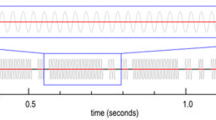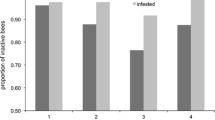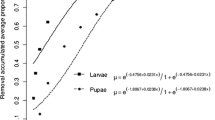Abstract
The ectoparasitic mite Varroa destructor is currently the most important pest of the honey bee, Apis mellifera. Because mite reproduction occurs within the sealed cell, the direct observation of varroa activity inside the cell is difficult. A video observation method using transparent polystyrol cells containing infested brood was used to analyze the behavior of varroa mites in worker brood of Africanized honey bees. We recorded how mites feed on the larva and pupa, construct a fecal accumulation site and how the bee larva carried out some longitudinal movements around the cell. The feeding activity of the foundress mite varies during the course of the cycle. On the prepupa mites were found to feed often (0.3 ± 0.2 bouts h−1) for a period of 8.7 ± 8.4 min h−1 and there was no preference for a specific segment as feeding site. On the opposite, during the pupal stage mites fed less often (0.1 ± 0.1 bouts h−1) for a period of 6.2 ± 4.0 min h−1 and almost always at a particular site (92.4%). On pupa, 83.7% of the feeding was on the 2nd abdominal segment (n = 92), and only few perforations were found on the thorax. Varroa shows a preference for defecation in the posterior part of the cell (cell apex), close to the bee′s anal zone. We found a high correlation between the position of the feeding site on the pupa and the position of the fecal accumulation on the cell wall. Most infested cells have only one fecal accumulation site and it was the favorite resting site for the mite, where it spent 24.3 ± 3.9 min h−1. Longitudinal displacements were observed in 28.0% (n = 25) of the analyzed bee larvae. Turning movements around the cell, from the bottom to the top, were carried out by these larvae, mainly during the second day (47.7 ± 22.5 min h−1), just before pupation, with a total time of 874.9 ± 262.2 min day−1 (n = 7 individuals). These results in worker brood of Africanized bees demonstrate adaptations of varroa mites to parasitizing the developing bee inside the capped brood cells.


Similar content being viewed by others
References
Anderson DL, Trueman JWH (2000) Varroa jacobsoni (Acari: Varroidae) is more than one species. Exp Appl Acarol 24:165–189. doi:10.1023/A:1006456720416
Bailey L, Ball BV (1991) Honey bee pathology. Academic Press, London
Boecking O, Ritter W (1993) Grooming and removal behavior of Apis mellifera intermissa in Tunisia against Varroa jacobsoni. J Apic Res 32:127–134
Boecking O, Spivak M (1999) Behavioural defenses of honey bees against Varroa jacobsoni Oud. Apidologie (Celle) 30:141–158. doi:10.1051/apido:19990205
Boot W, Tan NQ, Dien PC, Huan LV, Dung NV, Long LT, Beetsma J (1997) Reproductive success of Varroa jacobsoni in brood of its original host, Apis cerana, in comparison to that of its new host, Apis mellifera (Hymenoptera: Apidae). Bull Entomol Res 87:119–126
Büchler R (1994) Varroa tolerance in honey bees-occurrence, characters and breeding. Bee World 75:54–70
Calderón RA, Sommeijer MJ, de Ruijter A, van Veen JW (2003) The reproductive ability of Varroa destructor in worker brood of Africanized and hybrid honey bees in Costa Rica. J Apic Res 42:65–67
Carneiro F, Torres R, Strapazzon R, Ramirez S, Guerra J, Koling D, Moretto G (2007) Changes in the reproductive ability of the mite Varroa destructor (Anderson and Trueman) in Africanized honey bees (Apis mellifera L.) (Hymenoptera: Apidae) colonies in Southern Brazil. Neotrop Entomol 36:949–952. doi:10.1590/S1519-566X2007000600018
Correa-Marquez MA, Medina L, Martin S, De Jong D (2003) Comparing data on the reproduction of Varroa destructor. Genet Mol Res 2:1–6
De Jong D (1997) Varroa and other parasites of brood. In: Morse R, Flotum K (eds) Honey bee pests, predators, and diseases, 3rd edn. A I Root Co., Ohio, pp 280–327
De Jong D, De Jong PH, Goncalves LS (1982) Weight loss and other damage to developing worker honey bees (Apis mellifera) due to infestation with Varroa jacobsoni. J Apic Res 20:254–257
Donzé G, Guerin P (1994) Behavioral attributes and parental care of varroa mites parasiting honeybee brood. Behav Ecol Sociobiol 34:305–319. doi:10.1007/BF00197001
Donzé G, Guerin P (1997) Time-activity budgets and spacing structure by the different life stages of Varroa jacobsoni in capped brood of the honey bee, Apis mellifera. J Insect Behav 10:371–393. doi:10.1007/BF02765605
Donzé G, Fluri P, Imdorf A (1998) A Look under the Cap: the reproductive behavior of Varroa in the capped brood of the honey bee. Am Bee J 138:528–533
Erickson E (1996) Fecal accumulations deposited by Varroa can be used a simple field diagnostic for infestations of this honey bee parasite. Am Bee J 136:63–64
Erickson E, Cohen A, Cameron B (1994) Mite excreta: a new diagnostic for varroasis. Bee Sci 3:76–78
Garrido C, Rosenkranz P, Paxton RJ, Goncalves LS (2003) Temporal changes in Varroa destructor fertility and haplotype in Brazil. Apidologie (Celle) 34:535–541. doi:10.1051/apido:2003041
Grandi-Hoffman G, Page R, Martin J, Fondrk K (2002) Can the frequency of reduced Varroa destructor fecundity in honey bee (Apis mellifera) pupae be increased by selection? Apidologie (Celle) 33:563–570. doi:10.1051/apido:2002039
Ifantidis MD, Rosenkranz P (1988) Reproduktion der Bienenmilbe Varroa jacobsoni (Acarina: Varroidae). Entomol Gen 14:111–122
Kanbar G, Engels W (2004a) Visualisation by vital staining with trypan blue of wounds punctured by Varroa destructor mites in pupae of the honey bee (Apis mellifera). Apidologie (Celle) 35:25–29. doi:10.1051/apido:2003057
Kanbar G, Engels W (2004b) Number and position of wounds on honey bee (Apis mellifera) pupae infested by a single Varroa mite. Eur J Entomol 101:323–326
Korpela S, Aarthus A, Fries I, Hansen H (1993) Varroa jacobsoni Oud. in cold climates: population growth, winter mortality and influence on survival of honey bee colonies. J Apic Res 31:157–164
Martin SJ (1994) Ontogenesis of the mite Varroa jacobsoni Oud. in worker brood of the honeybee Apis mellifera L. under natural conditions. Exp Appl Acarol 18:87–100. doi:10.1007/BF00055033
Martin SJ (1995) Reproduction of Varroa jacobsoni in cells of Apis mellifera containing one or more mother mites and the distribution of these cells. J Apic Res 34:187–196
Mondragon L, Martin SJ, Vandame R (2006) Mortality of mite offspring: a major component of Varroa destructor resistance in a population of Africanized bees. Apidologie (Celle) 37:67–74. doi:10.1051/apido:2005053
Moretto G, Leonidas J (2001) Infestation and distribution of the mite Varroa jacobsoni in Africanized honey bees (Apis mellifera) colonies. Interciencia 26:393–396
Moretto G, Leonidas J (2003) Infestation and distribution of the mite Varroa destructor in colonies of Africanized bees. Braz J Biol 63:83–86. doi:10.1590/S1519-69842003000100011
Moretto G, Mello JL (1999) Varroa jacobsoni infestation of adult Africanized and Italian bees (Apis mellifera) in mixed colonies in Brazil. Genet Mol Biol 22:321–323. doi:10.1590/S1415-47571999000300006
Peng YS, Fang Y, Xu S, Ge L (1987) The resistance mechanism of the Asian honey bee Apis cerana Fabr. to an ectoparasitic mite, Varroa jacobsoni Oudemans. J Invertebr Pathol 49:54–60. doi:10.1016/0022-2011(87)90125-X
Ritter W, De Jong D (1984) Reproduction of Varroa jacobsoni O. in Europe, the Middle East and tropical South America. Z Ang Entomol 98:55–57
Spivak M (1996) Honey bee hygienic behavior and defense against Varroa jacobsoni. Apidologie (Celle) 27:245–260. doi:10.1051/apido:19960407
Szabo T, Walker T, Mueller A (1996) Grooming behavior as a varroa resistance characteristic in honey bee colonies. Am Bee J 136:515–517
Acknowledgments
We thank Dr. Anton Imdorf, Swiss Bee Research Centre, Switzerland, for providing us with the artificial transparent cells for the study of varroa mites and Dr. Gérard Donzé for his recommendations.
Author information
Authors and Affiliations
Corresponding author
Rights and permissions
About this article
Cite this article
Calderón, R.A., Fallas, N., Zamora, L.G. et al. Behavior of varroa mites in worker brood cells of Africanized honey bees. Exp Appl Acarol 49, 329–338 (2009). https://doi.org/10.1007/s10493-009-9266-y
Received:
Accepted:
Published:
Issue Date:
DOI: https://doi.org/10.1007/s10493-009-9266-y




